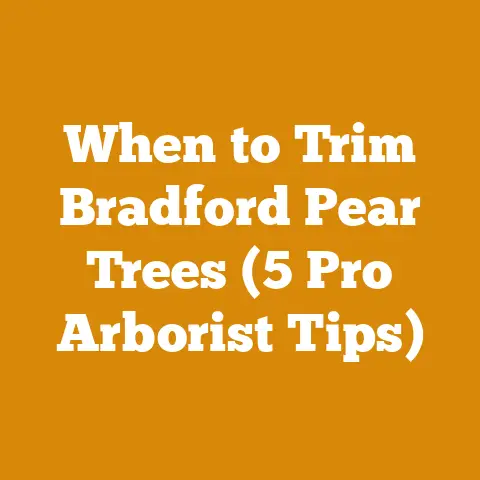Ash Bark Beetle Infestation on Felled Ash Timber (Woodcraft Insights)
Let’s talk about ash bark beetle infestations on felled ash timber. It’s a topic that hits close to home for anyone working with wood, whether you’re a seasoned logger, a small-scale firewood producer, or even a hobbyist woodworker. The presence of these tiny pests can drastically impact the resale value of your timber and the quality of your firewood. Understanding how to identify, manage, and prevent ash bark beetle infestations is crucial for preserving the value of your hard work and the health of our forests.
Understanding the Threat: Ash Bark Beetles and Felled Timber
Ash bark beetles, specifically those belonging to the Hylesinus and Leperisinus genera, can be devastating to felled ash timber. These beetles target stressed or recently dead trees, using them as breeding grounds. While a healthy, standing ash tree can typically defend itself, felled timber is vulnerable. The beetles bore into the bark, creating galleries that disrupt the flow of nutrients and water, ultimately degrading the wood. This degradation leads to staining, weakening, and a general loss of structural integrity, dramatically reducing the timber’s value.
Key Concepts to Define:
- Green Wood: Freshly cut wood with high moisture content. It’s heavier and more difficult to work with than seasoned wood.
- Seasoned Wood: Wood that has been dried to reduce its moisture content, making it lighter, more stable, and less prone to warping or decay.
- Felled Timber: Trees that have been cut down.
- Infestation: The presence of a large number of pests or parasites in an area or on an organism.
- Gallery: Tunnels or channels created by insects, like bark beetles, under the bark of a tree.
Identifying Ash Bark Beetle Infestation
The first step in managing this problem is knowing what to look for. Early detection is key to minimizing damage.
Signs of Infestation: What to Look For
Here’s what I look for when inspecting felled ash timber:
- Small Entrance Holes: These are tiny, usually pinhead-sized holes in the bark, where the beetles have bored into the wood.
- Frass: This is a mixture of beetle droppings and sawdust that accumulates around the entrance holes. It often looks like fine, reddish-brown dust.
- Bark Discoloration: Patches of discoloration on the bark, often brownish or reddish, can indicate underlying beetle activity.
- Gallery Patterns Under the Bark: If you peel back a section of bark, you might see intricate gallery patterns etched into the wood’s surface. These are the tunnels created by the beetles as they lay eggs and feed.
- Overall Tree Health (if applicable): Even before felling, look for signs of stress in standing ash trees, such as thinning crowns, dead branches, or excessive woodpecker activity (woodpeckers often feed on bark beetles).
Personal Story: I remember one time I was working on a large ash tree removal project. The trees looked healthy from a distance, but upon closer inspection, I noticed subtle discoloration on the bark of several trees. I decided to peel back a small section of bark, and sure enough, there were extensive gallery patterns underneath. We ended up having to adjust our milling plans and prioritize those trees to minimize further damage.
Recognizing the Culprits: Identifying Ash Bark Beetle Species
While several bark beetle species can attack ash, some are more common than others. Knowing the specific species can help you understand their behavior and the potential damage they can cause.
- Hylesinus fraxini: This is one of the most common ash bark beetles. It’s a small, cylindrical beetle that attacks the bark of ash trees.
- Leperisinus varius: This species is also frequently found on ash.
- Other Species: Other bark beetle species may also attack ash, depending on your geographical location. Consulting with a local entomologist or forestry expert can help you identify the specific species in your area.
Prevention Strategies: Protecting Your Felled Ash Timber
Prevention is always better than cure. Taking proactive steps to protect your felled ash timber can save you time, money, and headaches in the long run.
Best Practices for Handling Felled Ash Timber
- Prompt Processing: The longer felled ash timber sits, the more vulnerable it becomes to beetle infestation. Aim to process the timber as quickly as possible, ideally within a few weeks of felling.
- Debarking: Removing the bark eliminates the beetles’ habitat and food source. This is one of the most effective ways to prevent infestation.
- Proper Storage: If you can’t process the timber immediately, store it in a way that minimizes its attractiveness to beetles. This includes:
- Elevating the Logs: Use skids or other supports to keep the logs off the ground.
- Good Air Circulation: Ensure good airflow around the logs to help them dry out more quickly.
- Avoiding Shady Areas: Store the logs in a sunny location to help reduce moisture and discourage beetle activity.
- Water Sprinkling: Sprinkling the logs with water can deter beetles by making the surface less attractive for colonization.
- Strategic Felling: Avoid felling ash trees during peak beetle activity periods, which typically occur in the spring and summer.
Case Study: The Importance of Prompt Processing: A local sawmill I know had a large contract to mill ash lumber. They felled a significant number of trees but were delayed in processing them due to equipment breakdowns. By the time they got around to milling the timber, a large portion of it was infested with bark beetles, resulting in significant losses. This experience highlighted the importance of having a contingency plan in place to ensure prompt processing.
Chemical Treatments: When and How to Use Them
While I generally prefer non-chemical methods, there are situations where chemical treatments may be necessary, especially for high-value timber.
- Insecticides: Certain insecticides are labeled for use against bark beetles. Always follow the manufacturer’s instructions carefully and wear appropriate personal protective equipment (PPE).
- Application Methods: Insecticides can be applied as sprays, dips, or injections. The best method will depend on the specific product and the size and shape of the timber.
- Considerations:
- Environmental Impact: Be mindful of the potential environmental impact of chemical treatments. Choose products that are environmentally friendly and apply them responsibly.
- Regulations: Check local regulations regarding the use of insecticides. Some areas may have restrictions on certain products or application methods.
- Cost: Chemical treatments can be expensive, so factor this into your decision-making process.
Caution: Chemical treatments should be used as a last resort and only when other methods are not feasible. Always prioritize non-chemical methods whenever possible.
Managing Existing Infestations: Salvaging Infested Timber
If you discover that your felled ash timber is already infested with bark beetles, there are still steps you can take to minimize the damage and salvage as much of the wood as possible.
Assessment and Prioritization: Determining the Extent of the Damage
- Thorough Inspection: Carefully inspect all of your felled ash timber to determine the extent of the infestation. Look for the signs mentioned earlier, such as entrance holes, frass, and bark discoloration.
- Severity Levels: Categorize the timber based on the severity of the infestation:
- Lightly Infested: Only a few entrance holes and minimal gallery patterns.
- Moderately Infested: More numerous entrance holes and more extensive gallery patterns.
- Heavily Infested: Extensive damage with significant wood degradation.
- Prioritization: Prioritize the processing of the most heavily infested timber to prevent further damage.
Milling Strategies: Minimizing Losses During Processing
- Adjust Milling Plans: Adjust your milling plans to account for the presence of beetle damage. This may involve cutting away damaged sections or using different milling techniques.
- Utilize Damaged Wood: Even heavily infested wood can still be used for certain purposes, such as firewood or rough lumber for non-structural applications.
- Waste Disposal: Properly dispose of any infested bark or wood waste to prevent the spread of the beetles to other trees.
Personal Experience: I once had a client who had a large pile of ash logs that had been sitting for several months. When I inspected them, I found that they were heavily infested with bark beetles. We ended up having to adjust our milling plans significantly. We prioritized milling the most heavily infested logs first and salvaged as much of the wood as possible. We used the damaged wood for firewood and other non-structural applications.
Heat Treatment: A Viable Option for Eradication
Heat treatment is an effective method for killing bark beetles and other wood-boring insects. It involves heating the wood to a temperature that is lethal to the pests.
- Kiln Drying: Kiln drying is a common method of heat treatment. The wood is placed in a kiln and heated to a specific temperature for a specific duration.
- Steam Treatment: Steam treatment is another option. The wood is exposed to high-pressure steam, which penetrates the wood and kills the insects.
- Considerations:
- Cost: Heat treatment can be expensive, especially for large quantities of timber.
- Equipment: You will need access to a kiln or other heat treatment equipment.
- Wood Properties: Heat treatment can affect the wood’s properties, such as its moisture content and color.
Technical Details: The specific temperature and duration required for heat treatment will depend on the species of bark beetle and the size of the timber. Generally, a temperature of 140°F (60°C) for at least one hour will kill most bark beetles.
Firewood Preparation: Managing Beetles in Firewood
If you’re using infested ash timber for firewood, there are some additional considerations to keep in mind.
Splitting and Drying: Key Steps for Firewood Management
- Splitting: Splitting the firewood exposes the wood to air and sunlight, which helps it dry out more quickly and makes it less attractive to beetles.
- Drying: Properly drying firewood is essential for preventing beetle infestations. Aim for a moisture content of 20% or less.
- Stacking: Stack the firewood in a way that allows for good air circulation. This will help it dry out more quickly and discourage beetle activity.
Firewood Stacking Techniques: I’ve experimented with several firewood stacking techniques over the years. My favorite is the “Holz Hausen” method, which involves stacking the firewood in a circular shape with a hollow center. This method provides excellent air circulation and helps the firewood dry out quickly.
Burning Infested Firewood: Safety and Environmental Considerations
- Burning Seasoned Wood: Always burn seasoned firewood to minimize smoke and creosote buildup in your chimney.
- Avoid Storing Firewood Indoors: Storing infested firewood indoors can allow beetles to escape and infest other wooden structures in your home.
- Environmental Impact: Burning infested firewood can release beetles into the environment. While the beetles are unlikely to survive in a heated home, it is best to avoid storing infested wood indoors.
Safety Tip: Always have your chimney inspected and cleaned regularly to prevent chimney fires.
Tools and Equipment: Essential Gear for Ash Timber Management
Having the right tools and equipment can make a big difference in your ability to manage ash bark beetle infestations.
Felling and Processing Tools
- Chainsaws: A reliable chainsaw is essential for felling and processing ash timber. I recommend using a chainsaw with a bar length appropriate for the size of the trees you are felling. For larger trees, a chainsaw with a 20-inch or longer bar is necessary.
- Specifications: Consider a chainsaw with a displacement of 50-60cc for general use.
- Safety: Always wear appropriate PPE when using a chainsaw, including a helmet, eye protection, hearing protection, and chainsaw chaps.
- Axes and Mauls: Axes and mauls are useful for splitting firewood and removing bark.
- Specifications: A splitting maul with a weight of 6-8 pounds is ideal for splitting most firewood.
- Technique: Use proper technique when swinging an axe or maul to avoid injury.
- Log Splitters: A log splitter can make splitting firewood much easier and faster, especially for large quantities of wood.
- Hydraulic Splitters: Hydraulic log splitters are the most common type. They use hydraulic pressure to split the wood.
- Specifications: Look for a log splitter with a splitting force of at least 20 tons.
- Manual Splitters: Manual log splitters are a more affordable option, but they require more physical effort.
- Hydraulic Splitters: Hydraulic log splitters are the most common type. They use hydraulic pressure to split the wood.
- Debarking Spuds: A debarking spud is a specialized tool used for removing bark from logs.
Strategic Advantage: Using a hydraulic log splitter can significantly increase your efficiency when preparing firewood, especially if you are dealing with large quantities of wood. It also reduces the risk of injury compared to using an axe or maul.
Safety Gear: Protecting Yourself from Injury
- Helmets: Always wear a helmet when felling trees or working with chainsaws.
- Eye Protection: Wear safety glasses or goggles to protect your eyes from flying debris.
- Hearing Protection: Use earplugs or earmuffs to protect your hearing from the noise of chainsaws and other equipment.
- Chainsaw Chaps: Wear chainsaw chaps to protect your legs from chainsaw injuries.
- Gloves: Wear gloves to protect your hands from splinters and other injuries.
- Steel-Toed Boots: Wear steel-toed boots to protect your feet from falling logs and other hazards.
Safety First: Always prioritize safety when working with wood. Take the time to properly train yourself on the safe use of all tools and equipment.
Cost Analysis: Evaluating the Economic Impact of Infestations
Understanding the economic impact of ash bark beetle infestations can help you make informed decisions about how to manage the problem.
Assessing the Financial Losses
- Reduced Timber Value: Infested timber is worth less than uninfested timber. The extent of the reduction will depend on the severity of the infestation and the intended use of the wood.
- Increased Processing Costs: Processing infested timber can be more time-consuming and labor-intensive, which can increase your processing costs.
- Loss of Firewood Value: Infested firewood may be worth less than uninfested firewood.
- Treatment Costs: Chemical treatments and other management strategies can be expensive.
Example: A sawmill that purchases infested ash logs may have to pay a lower price for the logs to compensate for the reduced timber value and increased processing costs.
Calculating the Return on Investment (ROI)
- Benefits: The benefits of managing ash bark beetle infestations include preserving the value of your timber, reducing processing costs, and protecting the health of your forest.
- Costs: The costs include the cost of treatments, equipment, and labor.
- ROI Calculation: To calculate the ROI, divide the benefits by the costs. A positive ROI indicates that the investment is worthwhile.
Strategic Insight: By carefully assessing the costs and benefits of different management strategies, you can make informed decisions that will maximize your ROI.
Drying Methods: Achieving Optimal Moisture Content
Properly drying ash timber is crucial for preventing decay, warping, and further beetle infestations.
Air Drying: A Traditional and Cost-Effective Method
- Stacking: Stack the timber in a way that allows for good air circulation. Use stickers (small pieces of wood) to separate the layers of timber.
- Location: Choose a location that is sunny and well-ventilated.
- Time: Air drying can take several months or even years, depending on the climate and the thickness of the timber.
Moisture Content Targets: Aim for a moisture content of 12-15% for most woodworking applications.
Kiln Drying: A Faster and More Controlled Method
- Kiln Operation: Kiln drying involves placing the timber in a kiln and controlling the temperature, humidity, and airflow.
- Time: Kiln drying is much faster than air drying, typically taking only a few days or weeks.
- Cost: Kiln drying is more expensive than air drying.
Technical Details: The specific kiln drying schedule will depend on the species of wood and the desired moisture content.
Personal Story: I once had a batch of ash lumber that I needed to dry quickly. I decided to use a kiln drying service. The lumber was dried to the desired moisture content in just a few days, saving me a significant amount of time.
It’s important to be aware of any legal and regulatory considerations related to ash bark beetle infestations in your area.
Reporting Requirements
- State and Local Regulations: Some states and local governments may have regulations requiring you to report ash bark beetle infestations.
- Forestry Agencies: Contact your local forestry agency to learn about any reporting requirements in your area.
Quarantine Zones
- Emerald Ash Borer: Be aware of any quarantine zones related to the emerald ash borer, another invasive pest that attacks ash trees.
- Restrictions: Quarantine zones may restrict the movement of ash timber and firewood.
Caution: Failure to comply with legal and regulatory requirements can result in fines or other penalties.
Global Perspectives: Addressing the Issue Worldwide
Ash bark beetle infestations are a global problem, affecting ash trees in many countries around the world.
International Collaboration
- Research and Monitoring: International collaboration is essential for research and monitoring of ash bark beetle populations.
- Best Practices: Sharing best practices for managing infestations can help to protect ash trees worldwide.
Challenges Faced by Global DIYers and Small-Scale Businesses
- Limited Resources: DIYers and small-scale businesses may have limited resources for managing ash bark beetle infestations.
- Access to Information: Access to information about best practices may be limited in some areas.
Strategic Insight: By working together, we can develop effective strategies for managing ash bark beetle infestations and protecting ash trees around the world.
Next Steps and Implementation Guidance
Now that you have a better understanding of ash bark beetle infestations, here are some practical next steps you can take:
- Inspect Your Ash Timber: Carefully inspect your felled ash timber for signs of infestation.
- Implement Prevention Strategies: Implement the prevention strategies discussed in this guide.
- Manage Existing Infestations: If you discover that your timber is already infested, take steps to minimize the damage and salvage as much of the wood as possible.
- Educate Others: Share this information with other woodworkers, loggers, and firewood producers.
- Stay Informed: Stay informed about the latest research and best practices for managing ash bark beetle infestations.
By taking these steps, you can help to protect your ash timber and the health of our forests. The key is vigilance and proactive management. Remember, even small actions can make a big difference in the long run. Good luck!






